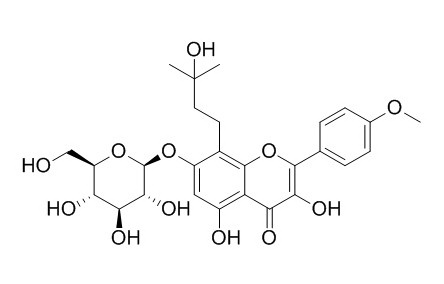Maohuoside A
Maohuoside A promotes osteogenesis of rat mesenchymal stem cells via BMP and MAPK signaling pathways.
Inquire / Order:
manager@chemfaces.com
Technical Inquiries:
service@chemfaces.com
Tel:
+86-27-84237783
Fax:
+86-27-84254680
Address:
1 Building, No. 83, CheCheng Rd., Wuhan Economic and Technological Development Zone, Wuhan, Hubei 430056, PRC
Providing storage is as stated on the product vial and the vial is kept tightly sealed, the product can be stored for up to
24 months(2-8C).
Wherever possible, you should prepare and use solutions on the same day. However, if you need to make up stock solutions in advance, we recommend that you store the solution as aliquots in tightly sealed vials at -20C. Generally, these will be useable for up to two weeks. Before use, and prior to opening the vial we recommend that you allow your product to equilibrate to room temperature for at least 1 hour.
Need more advice on solubility, usage and handling? Please email to: service@chemfaces.com
The packaging of the product may have turned upside down during transportation, resulting in the natural compounds adhering to the neck or cap of the vial. take the vial out of its packaging and gently shake to let the compounds fall to the bottom of the vial. for liquid products, centrifuge at 200-500 RPM to gather the liquid at the bottom of the vial. try to avoid loss or contamination during handling.
Trop J Pharm Res.2023, 22(3):283-288.
J Separation Science & Technology2016, 51:1579-1588
Molecules.2023, 28(4):1526.
JEJU National University2022, 24032.
J Health Sci Med Res.2023, 31584.
Sci Rep.2019, 9(1):6429
Eur J Pharmacol.2021, 906:174220.
Oncotarget.2015, 6(31):30831-49
Int J Mol Sci.2021, 22(11):5503.
Curr Res Food Sci.2024, 9:100827.
Related and Featured Products
Phytother Res. 2013 Aug;27(8):1179-84.
Maohuoside A acts in a BMP-dependent manner during osteogenesis.[Pubmed:
23007945]
There has been a strong interest in searching for natural therapies for osteoporosis. Epimedium koreanum Nakai is an herb that is commonly used in East Asia to treat osteoporosis, and most studies of its activity have focused on its major ingredient, icariin.
METHODS AND RESULTS:
In this study, Maohuoside A (MHA), a single compound isolated from the E. koreanum, was found to promote osteogenesis in mouse bone marrow-derived mesenchymal stem cells. We hypothesise that, if Maohuoside A potently induces osteogenic differentiation in a bone morphogenetic protein-dependent manner, it may be used to broaden the sources for cell transplantation and thereby establish more efficient bone regeneration systems. Real-time polymerase chain reaction and western blot were used to detect the expression of SMAD4, a marker of bone formation. Microcomputed tomography and histomorphometric techniques showed that oral treatment with Maohuoside A was followed by an increase in the bone mineral density of the lumbar vertebrae in mice. This result also indicates that Maohuoside A may directly activate osteopontin gene transcription.
CONCLUSIONS:
In conclusion, Maohuoside A seems to enhance the osteogenesis of bone marrow-derived mesenchymal stem cells at least partly via bone morphogenetic protein signalling.
Mol Cell Biochem. 2011 Dec;358(1-2):37-44.
Maohuoside A promotes osteogenesis of rat mesenchymal stem cells via BMP and MAPK signaling pathways.[Pubmed:
21698346]
Osteoporosis is becoming a more prevalent health problem with the aging of the population around the world. Epimedium koreanum Nakai is one of the most used herbs in East Asia for curing osteoporosis, with its major ingredient, icariin, mostly explored by researchers.
METHODS AND RESULTS:
In this article, Maohuoside A (MHA), a single isolated compound from the herb, was identified to be more potent than icariin in promoting osteogenesis of rat bone marrow-derived mesenchymal stem cells (rMSCs) (increasing by 16.6, 33.3, and 15.8% on D3, D7, and D11, respectively). Alkaline phosphatase (ALP) assay and calcium content measurement were assigned to quantify the promoted osteogenesis and alizarin red S (ARS) staining was conducted to visualize it. Quantitative real-time PCR (Q-PCR) was assayed to evaluate the mRNA expression of marker genes in osteogenesis and master regulators in BMP pathway. Moreover, PD98059 (PD) and SB203580 (SB), inhibitor of ERK1/2 and p38 MAPK pathway, were administered to assess the involvement of MAPK pathway in the promotion process.
CONCLUSIONS:
In conclusion, MHA pronouncedly enhanced the osteogenesis of rMSC, plausibly via the BMP and MAPK signaling pathways.



